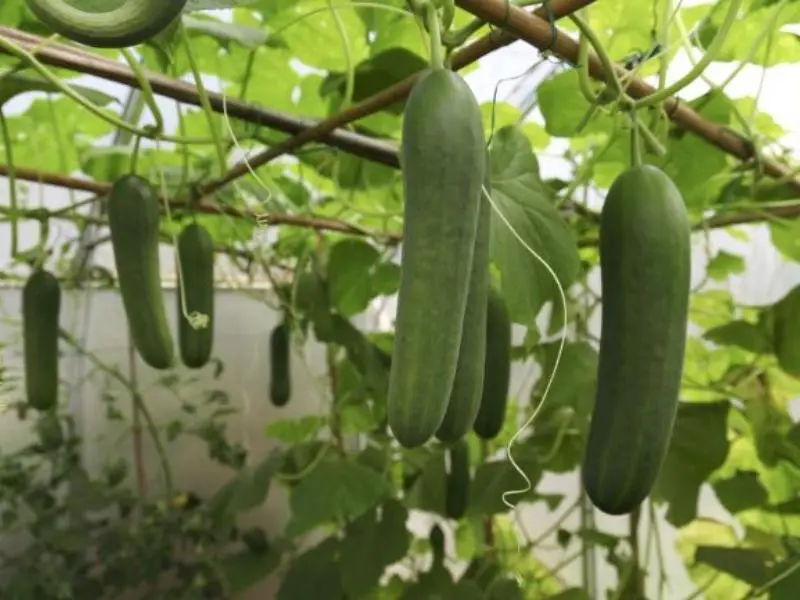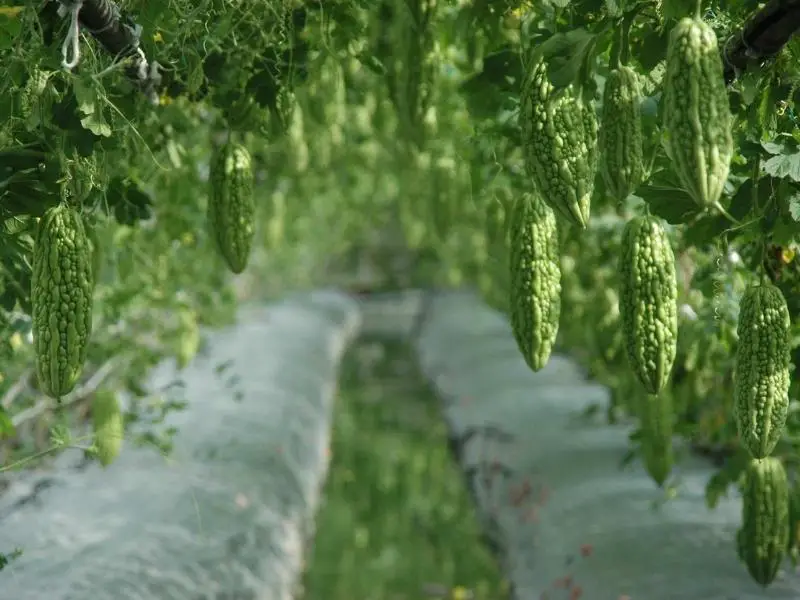
Climbing vegetables are trailing plants that are encouraged to creep up a support structure. Gardeners with limited space, especially urban gardeners, can enjoy the benefits of a large crop by planting climbing vegetables.
Growing vegetables vertically encourages prolific growth and reduces the likelihood of diseases like mold and fungus growth. Vertical growth also prevents pest infestations because the air is able to circulate freely around the plants.
Best Climbing Vegetables & Fruits List
Vegetables can grow vertically when planted in the ground or in a container with something to climb like a trellis, archway, or a few lengths of horizontal wire.
Beans

Kidney beans, haricot verts, and tall bean plants — like green beans — are easy vegetables to grow vertically. Plant the bean seeds in the ground or a container. Add poles or a trellis, for support, directly behind the plant. Choose a spot with either full or partial sunlight.
Water the beans lightly twice a week. Train the tendrils to climb by threading them through a support structure as soon as they’re long enough. Harvest the beans as soon as the pods are full and plump encourages the plant to give a larger yield.
Cucumbers

Vining cucumbers do well in a vertical garden when planted in a sunny spot that is sheltered from the wind. Plant the seeds 1 inch deep in a container or in the ground. Water the cucumbers twice a week.
When the seeds begin to sprout, encourage vertical growth by threading the tendrils through the support structure. Cucumbers thrive on a teepee-like structure made from 3 poles. Tie the plant securely to the poles to prevent it from collapsing under the weight of the cucumbers.
Harvest the cucumbers frequently to encourage more growth and to prevent the plant from toppling over due to weight.
Peas

Peas grow vertically without much attention or help. The tendrils attach themselves to a trellis or piece of wire and automatically grow upwards.
Snow peas flourish the best when planted in a sunny spot. Sow seeds in early spring for a bountiful crop and continue planting until mid-summer to ensure a constant supply. Frequent harvesting creates more growth.
Pumpkins

Small pumpkin varieties, like baby boos and bumpkins, are good climbers that can grow vertically with enough support. Plant the seeds in containers and train the vines to climb a sturdy support structure.
Tie a sling or hammock-like piece of netting under the pumpkins as they grow to support their weight and prevent the structure from collapsing. Harvest the pumpkins as soon as they ripen to promote new growth.
Bitter Melons

Bitter melons, or bitter gourds, are vine vegetables that grow easily on a vertical structure. These plants are best suited to tropical and subtropical climates, so keep the plants in a spot with full sunlight. Plant bitter melons in early spring for a plentiful summer harvest.
These gourds are tall plants that grow rapidly, so ensure that the trellis is at least 6 feet tall and is solid enough to support the plant’s weight. A horizontal sling or hammock will provide good support.
Malabar Spinach

Malabar spinach is climbing spinach that can be planted from seed or from a cutting. This plant grows prolifically on a trellis. Water these spinach plants frequently to encourage the growth of edible leaves and to avoid flowering, which slows the harvest.
Plant Malabar spinach in full sun or partial shade and train the plant to climb a trellis by threading the tendrils up the support structure. Water every three to four days and cut the leaves frequently to promote further growth, yielding a plentiful crop.
Tomatoes

Tomatoes are easy to grow vertically when planted in a sunny spot, either in a container or directly in the ground. Sow seeds in late spring or early summer, and provide a strong support structure such as a trellis or wire tied to support poles.
Placing the trellis in front of a wall provides more support for big plants with large produce.
Encourage the tomato plant to climb the support structure by threading the stalks up the trellis. Harvest the tomatoes as soon as they begin to ripen to prevent the plant from becoming overladen with fruit and collapsing under the weight.
Strawberries

Plant strawberries in a container in full sun in front of a trellis and water daily. As the plant grows, it develops long runners that can be trained to climb a support structure.
The fruit will hang down and should be harvested as soon as it ripens.
Grapes

Grapes are a natural vine fruit, with all varieties climbing automatically as they grow. Plant different varieties of grapes at different times of the year depending on your agricultural zone for a year-round harvest.
Grapes are more stable and produce more fruit when planted directly in the ground in front of a permanent support structure like a wattle fence. These perennial plants sometimes take a few years to fully establish.
Harvest the grapes as soon as they ripen and prune the plant regularly to encourage healthy growth.
Passionfruit

Passionfruit is a tropical evergreen and natural climber that needs a permanent support structure. Plant passionfruit directly in the ground in a sunny position in front of a fence or trellis.
Start training the tendrils up the support structure as soon as they poke through the ground. Water the passionfruit frequently to encourage healthy growth, and harvest the fruit as soon as it begins to ripen. Frequent harvesting encourages new fruit production.
Kiwis

Kiwis are fast vine growers that do well in a vertical garden if they have a sturdy support structure. This fruit is dioecious, which means that the male and female plants are separate, and the two plants must be planted together for the female to bear fruit.
At least one male kiwi plant is needed for every eight female plants.
Plant male and female kiwis in full sun in early spring for a bountiful summer crop. Train the main stem of the kiwi plant to climb up the trellis until the stem reaches a length of 6 feet, at which point the side shoots can be allowed to spread along the trellis on their own.
Harvest the fruit as soon as it ripens and prune the plant regularly to encourage new growth.
How to Grow Vine Vegetables & Fruit

Here are some tips and tricks for successfully growing fruits and vegetables vertically:
- Ensure that the support structure is strong
- Place a trellis in front of a supporting wall to provide more stability
- Provide horizontal support in the form of a sling or hammock to support heavy fruits and vegetables
- Plant individual vines with enough space between them to allow enough air to circulate around the fruit
- Use good quality soil and fertilizer to encourage healthy growth
Growing climbing vegetables is a great way to make the most of limited garden space, allowing you to enjoy the benefits of homegrown crops.






